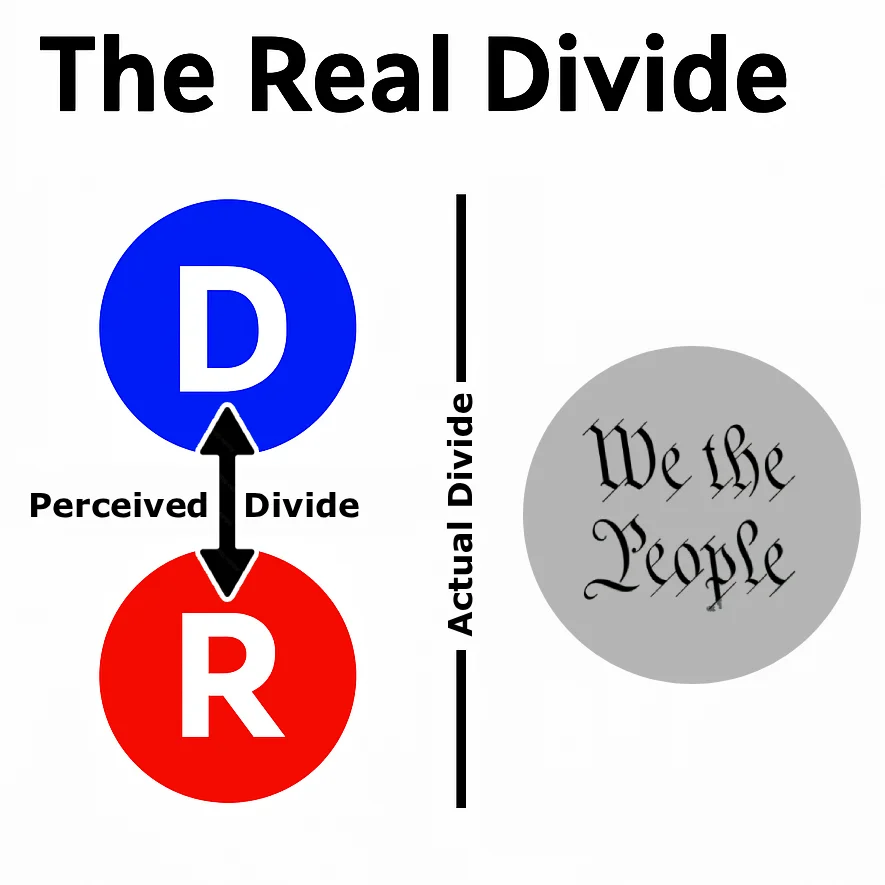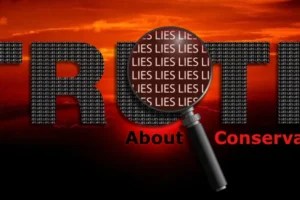The Delusion of Choice is Federalism
What comes to mind when you hear the word Federalism? For most Americans, politics is framed as a clash of opposites: red versus blue, Republican versus Democrat, conservative versus progressive. That story is easy to sell, but is it actually true? Have you considered that this might be less a genuine divide and more a false dilemma?
By definition, Federalism unites separate states under a single overarching political system, allowing each state to retain a degree of integrity while remaining subordinate to a larger authority. In plain terms, it is big government. Accordingly, this centralized authority concentrates power at the top while diminishing the relative independence of both the states and the people beneath it.
None of this is likely new to you. This is the system you know because it is the system you live in. What may be less obvious is that the “red versus blue” narrative, the supposed battle between Democrats and Republicans, masks the fact that both are committed to Federalism. I would argue that the divide they sell you is, in many ways, an illusion.
Consider the fact that independents and third-party adherents outnumber both Republicans and Democrats combined, yet the red and blue dominate the stage. Why? Perhaps because their true commonality is more important than their differences. I would then argue that if both parties serve the same master (Federalism itself), then choosing a red Federalist or a blue Federalist is no real choice at all. You’re still choosing federalism.
And have you ever noticed what happens whenever Anti-Federalist ideas emerge? Don’t the red and blue tribes suddenly stand shoulder to shoulder to shut them down or hinder their progress? When you see this for what it is, the entire political discourse begins to look very different.
Federalists vs. Anti-Federalists at the Founding
The original divide was never “right” versus “left.” It was Federalist versus Anti-Federalist. Federalists such as Alexander Hamilton and John Jay argued for a strong central government, consolidated finance, and national authority. Anti-Federalists, including Patrick Henry, George Mason, Richard Henry Lee, Samuel Adams, and Thomas Jefferson, warned that concentrated power in a distant capital would erode liberty and reduce citizens to subjects. And although he began as a committed Federalist, even James Madison ultimately saw the dangers of Federalism and eventually aligned himself with the Anti-Federalists.
The Constitution gave the Federalists their victory. The Anti-Federalists salvaged only the Bill of Rights. From that moment on, the momentum has always flowed in one direction… toward consolidation, just as the Anti-Federalists warned. Accordingly, today, there is not a single right in the Bill of Rights that is not currently being infringed upon to some degree, and not a single Federalist “Constitutional defender” is doing anything about it. It appears the Anti-Federalists were right, and today we have a revolving door of power that largely omits the American people from prosperity.
The Federalist Narrative Machine
Unfortunately, it was not just the government that the Federalists captured. To win at this game, they needed to capture education and the overall narrative. This is what Jefferson tried to warn everyone about when he said that the state shouldn’t control education, only pay for it. Unfortunately, the Federalists were successful. The Federalists now control education, and it is a highly funded machine of narratives. This ensures that people are only exposed to the narratives they wish to promote. In other words, a Federalist education produces and favors Federalist narratives.
From textbooks to civic instruction, the story told is always the same: centralized authority is natural, necessary, and permanent. Other visions of liberty are pushed aside, dismissed as dangerous or unrealistic. Leaders resistant to the Federalist cause are demonized. This conditioning starts early and ensures alternatives are rarely explored. This is precisely why I say that “Indoctrination Starts Before College,” and why true patriotic Americans are conditioned to hate higher education.
Of course, this is also why so many Americans cannot even name an Anti-Federalist, let alone explain their warnings. The system was designed to bury them. On that note, this also explains why many are completely unaware of the true stories of those who stood in defiance of that system, and why only whispers of the truth are shared by those who happen upon such stories.
(Dropdown): Thomas Jefferson on Public Education
In true Anti-Federalist fashion, Thomas Jefferson was very clear that education should not be under centralized state or federal control. He argued it belonged with the people themselves, often at the local or ward level. The most direct line that captures this is from his 1816 letter to Joseph Cabell:
“I look to the diffusion of light and education as the resource most to be relied on for ameliorating the condition, promoting the virtue, and advancing the happiness of man. And I do not think it can be done by the federal government. It is not authorized in their charter of delegation of powers; and, to assume it, would be an act of usurpation. It is, however, a duty of every state to provide it for its own citizens, and I have no doubt, if it is left to the states, it will be done.”
(Thomas Jefferson to Joseph C. Cabell, 1816)
In other writings, Jefferson stressed that education should be handled locally, not by distant authorities:
“The influence over government must be shared among all the people. If every man has to take part in the government of affairs, he must be educated. We must therefore educate and instruct the whole mass of the people. The expense of this should be borne by the state, but by the state divided into wards and districts.”
(Thomas Jefferson to Joseph C. Cabell, 1816)
Interestingly, Jefferson also said that “If a nation expects to be ignorant and free, in a state of civilization, it expects what never was and never will be.” Indeed. However, he also knew that such education would come at a cost. So, he suggested that the government be responsible for purchasing that education. In 1786, Thomas Jefferson told George Wythe that any “tax which will be paid for [the] purpose [of education] is not more than the thousandth part of what will be paid to kings, priests and nobles who will rise up among us if we leave the people in ignorance.”
So Jefferson’s position wasn’t against public education, but against centralized state or federal monopoly control. He believed schooling should be funded by the government and organized locally, closest to the people, to prevent government overreach. But you were conditioned to advocate for the exact opposite: a Federalist system.
Demonization of Anti-Federalism
The erasure of Anti-Federalism was not an accident. Instead, it was an overtly strategic move. From the earliest days, those who sympathized with Anti-Federalists were demonized, often portrayed as backward or disloyal. Their concerns were reduced to caricature while Federalist victories were celebrated as progress.
This pattern intensified during the Civil War. Anything resembling Federalism was praised as noble and necessary, while anything resembling Anti-Federalism was vilified as rebellion or treason. It did not matter whether the centralizers leaned left or right. If the outcome resulted in a bigger government, history recorded it in glowing terms.
The same framing appeared again and again in later history:
- The Bonus Army (1932): World War I veterans camped in Washington, demanding the early payment of bonuses they were owed. They took a stand as people. However, they were painted as dangerous agitators and crushed with military force under the authority of the federal government.
- The New Deal (1930s): Massive federal expansion was hailed as salvation from the Depression, while critics who feared it would lead to dependency and bureaucracy were dismissed as callous or ignorant.
- The Civil Rights Era (1960s): Federal intervention was celebrated as progress, while resistance (even when based on local autonomy arguments rather than outright racism) was automatically cast as immoral or illegitimate.
The pattern is consistent: if it grows government, it is written in history as a good thing. If it resists centralization, it is demonized, no matter the context. Now, if you give that any real thought, you might also notice that pattern showing itself in administration after administration. The tactic is rather simple: they get you to dislike or even hate one federalist side, so you naturally gravitate to its opposing federalist side, leaving you to ignore the true side you likely want to be on, which is the people’s side. It works so well because emotion drives bias.
The Modern Fear of Decentralization
Indeed, the encroachment of legitimate threats, such as communism and Marxism, has encouraged the expansion of the Federal government. The threat is real, but it was also a rather convenient selling tool to get the population to buy into greater Federal control in the name of “safety.” These tactics continue to this day. But you will note that the solution of education and personal empowerment are not the options they want you to have. It must be they who have the power, and you must be dependent on that power. That one can be hard to wrap your head around, so let’s explore a few other examples.
After 9/11, the same Federalist instinct took over. The attacks were used to justify massive expansions of centralized power through measures like the PATRIOT Act, the creation of the Department of Homeland Security, and sweeping and illegal/unconstitutional surveillance programs. Any suggestion of decentralization, restraint, or constitutional limits was dismissed as naïve or even unpatriotic in the face of terrorism. Citizens were told to trust in government authority and accept reduced freedoms in exchange for safety. Once again, history framed the growth of federal power as strength, while resistance to it was cast as weakness or disloyalty.
We saw another great example during the COVID pandemic, where the Federalist reflex was on full display. Centralized government expanded rapidly through mandates, lockdowns, and sweeping restrictions, all justified as necessary for public safety. Those who questioned the measures, sought local solutions, or advocated for individual choice were demonized as reckless, dangerous, or even enemies of society. Medical experts who questioned were immediately labeled as “quacks,” and many lost their careers. Of course, the narrative was not about balancing liberty with responsibility but about reinforcing the idea that only centralized authority could manage the crisis. Once again, anything resembling decentralization was portrayed as chaos, while larger government was portrayed as salvation.
These examples go on and on:
- Cryptocurrency: Promoted as a way to bypass central banks and government-controlled monetary systems, crypto is constantly attacked as dangerous, unstable, or criminal. Regulation and restriction always expand under the banner of “protection,” and those who engage are always under the threat of big government. But a central bank crypto or digital currency, that’s (evidently) a good idea. Accordingly, any nation that seeks to step away from the central bank is considered an enemy that needs to be eliminated.
- Decentralized Finance (DeFi): Peer-to-peer lending, smart contracts, and blockchain platforms threaten the monopoly of traditional financial institutions. They are smeared as scams, while centralized systems riddled with fraud and manipulation are defended as “too big to fail.”
- Decentralized Media & Platforms: Efforts to create alternative, censorship-resistant platforms face relentless labeling as havens for “misinformation” or “extremism.” The goal is to delegitimize them before they gain traction. The only media that is “trustworthy” is the media they sign off on.
- Decentralized Technology & Privacy Tools: Encrypted communication, decentralized file-sharing, and privacy-focused systems face constant hostility because they undermine surveillance capabilities. Tools that empower individuals are consistently reframed as tools that “empower criminals.”
Are you starting to notice the theme? These examples continue, and each echoes the same Federalist reflex that has existed since the founding: decentralization is a danger, centralization is the solution. It’s continuing to this very day. Just look at some of the representatives and senators who don’t toe their party line or who prioritize the people’s interests over their party’s. Are they not marginalized or badmouthed?
My favorite rhyme is “It doesn’t matter if it’s red or blue; it’s likely going to get used against you.” Think about what that truly means. Yes, the times, the clothes, the leaders, and technology all change, but the narrative remains the same.
Who Controls the Narrative Now?
The ultimate irony is that state education is now controlled by the very structure the Anti-Federalists feared: big government. Accordingly, all of Jefferson’s warnings go entirely untaught. That makes total sense. Why would a Federalist system teach you about the things that threaten its power?
The federal model writes the curriculum, funds the institutions, and frames the story. It celebrates the expansion of power while ignoring, minimizing, or demonizing those who resist it. Think about it. To this day, the founders who stood against centralization are often remembered not as visionaries but as troublemakers, bigots, or whatever else the popular slurs are at the time.
The result is self-reinforcing. Federalism means big government, small people. Accordingly, the people feel small in the face of big government. And the bigger the government grows, the more control it has over the stories we tell about ourselves and the beliefs we hold about what any of us can do about it.
The further this goes, the more you are taxed, the less freedom you have, and the more control they get. Interestingly, you could look at the supposed threat often portrayed regarding private schools, conservative colleges, or homeschooling. Have you ever heard that these options are dangerous? The question you need to ask is, Dangerous to whom and why?
The Bipartisan Reflex Against Anti-Federalism
I want you to notice how every time a genuine Anti-Federalist alternative emerges, whether in the form of decentralist populism, third parties, or candidates who challenge the establishment, the red and blue teams close ranks. They limit ballot access, bar debate participation, create regulations, and frame dissenters as radicals or threats. The red-blue rivalry evaporates when the structure itself is questioned.
Of course, this is not an accident, and it’s definitely not an anomaly. Systems protect themselves. These supposedly competing factions may quarrel loudly for the cameras, but when the survival of the system is at stake, they stand together. You know this is true. You’ve probably seen or felt it at some time. My favorite ones are the pictures of the golf games on the weekends, or how those who engage in unethical behaviors are never held accountable.
Final Thoughts

The truth is fairly straightforward when you know what to look for. Choosing between a red Federalist and a blue Federalist is still a choice for Federalism. Think about it. The only time you see true unity in Washington is when an Anti-Federalist threatens the arrangement. That alone should tell you everything you need to know. There is a perceived divide, as well as an actual one. When you know the lines, you know what to look for.
Of course, it is critically important to understand that a Federalist education produces Federalist narratives. You’re not going to get the whole story from a system that doesn’t want you to know something. So, what important facts or points have been omitted from your understanding? I would argue that it’s quite a bit. Heck, this website probably proves that.
Federalism is big government and small people. Until Americans rediscover the Anti-Federalist tradition and confront how history has been framed to erase it, they will remain trapped in a delusion of choice while the system grows stronger and the people grow weaker. That is the reality, whether we like it or not. Yet the alternative is not an all-or-nothing proposition. The idea that we must choose between total government and no government is another binary meant to trap you, because the no-government alternative is also doomed to failure.
Of course, that is the point you are not supposed to see. The Federalist design has always been to make government bigger than the individual, to make the system more powerful than the people who sustain it. Once you understand that, the delusion begins to collapse. Red versus blue is not true opposition; it’s theater. The real contest is between centralization and decentralization, between Federalists and the Anti-Federalist spirit that still lingers in those who resist being absorbed by the machine.
Although most Americans have never been exposed to them, I believe it is worthwhile to read and explore the Anti-Federalist Papers. The Anti-Federalists warned us that consolidated power would eventually become tyrannical, and they were right. The only question now is whether we will continue to accept the delusion of choice, or whether we will revive that lost tradition of defiance.
Granted, it’s going to be a tough battle. The system will demonize and attack every attempt to decentralize, regardless of its form. I believe that the Anti-Federalists’ warnings remain highly relevant today. They are just waiting to be rediscovered by true patriots. And frankly, that rediscovery might be the only chance the people have left to reclaim their place above the government, rather than beneath it.
It’s just something to consider, but time appears to be running short.
(Dropdown): Clarity on that Point from Thomas Payne
Thomas Paine reminded us in Common Sense that “government, even in its best state, is but a necessary evil.” That insight is crucial for understanding the Anti-Federalist position. To reject Federalism is not to reject all government, nor is it to embrace an anarchic free-for-all. The Anti-Federalists understood that society requires structure, law, and shared responsibility. Interdependence, not isolation, is what allows communities to thrive.
The difference lies in how that “necessary evil” is caged. From the Anti-Federalist perspective, government must exist, but only in a form small enough to be restrained by the people it serves. It should provide order without smothering independence, ensure justice without amassing power that cannot be checked, and operate close enough to the citizenry that accountability remains real. When power drifts upward into distant capitals or entrenched bureaucracies, it ceases to be a servant and becomes a master.
This is why it is inaccurate to frame the debate as a stark choice between “big government” or “no government.” Anarcho-capitalism, pure volunteerism, or similar systems that deny the need for any governing framework fall into their own form of dysfunction. Left unchecked, they can collapse into chaos, exploitation, or rule by private monopolies and warlords. At the other extreme, expansive centralized government tends toward stagnation, coercion, and control. Both ends of that spectrum erode the reciprocal bonds that sustain a healthy society.
The Anti-Federalist position recognized the tension between necessity and danger. The government must exist, but it must be kept small, local, and accountable. It is a necessary evil, but one that can and must be restrained within tight boundaries if liberty and genuine self-government are to survive. That is why the Bill of Rights is not a list of privileges the government provides to the people, but a list of rules the people have given to the government, which they are not to break.
Keep Learning:
The Coming Battle for Core Values
How the Machine Suppresses Truth




